I’ve done a lot of different kinds of quilts, but there are some quilt patterns I am drawn back to doing, maybe doing in new ways, maybe refining. I always love quilts with motion, like Kaleidoscope (click on Kaleidoscope in Categories to see instructions and variations) and another is Sloppy Stars.
It’s the hot, humid steamy season in Pensacola. It’s like winter in Alaska, it’s a good time to stay inside with your sewing machine and fabric except for when you need groceries, or to meet up with friends, or go to church, or even exercise – those are the exceptions. When it is steamy, it’s a great time to quilt.
One reason I love Sloppy Stars is that it makes such economical use of fabrics. You cut fat quarters – actually I cut mine to something like 18 inches square now – and slice, and then seam – no excess, except at the end when you trim as little as you have to on the outside, to make the blocks a uniform size. My goal is 15″ finished squares and now I am pretty good at getting them. My favorite part is picking out the fabrics. I don’t know exactly how they will look in the end, but that is part of the fun – getting fabrics that will jive and thrive, with a little bit of drama 🙂
The original instructions for Sloppy Stars are here; these are just refinements I have come up with after doing so many of them. My stars have gotten bigger and bigger; it’s a dramatic cut and I like the efficiency of using a 15″ block. I have two different patterns I use, one is fairly straight, and one is very slanted and wonky. I find I am more drawn to the wonky one, guess I am a wonky one, too. These are drafted on 16″ graph paper I find in books at JoAnne Fabrics.
Because I ran short on freezer paper, I only had enough for two identical copies instead of four. I should’ve gone to the store for freezer paper – cutting 25 layers of fabric was more than my cutter could handle. I got some truly jaggy edges. If you are going for the 50 blocks (25 light 25 dark), do two cuts for each set; 12/13 is enough of a challenge for your rotary cutter. I will never try to cut 25 layers again. Never.
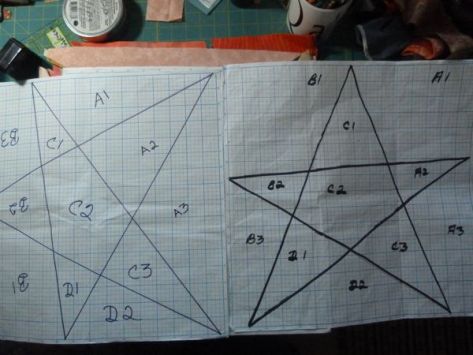
I never string piece this block. I have learned from BAD experiences! I keep all the pieces flat; and the two sets (I do one with dark background light stars and one with light background dark stars) are kept separate. I always do one block at a time; each block takes about 12 minutes, I take it slow. It goes together fast, so it pays to go slow so you don’t mix up pieces. Keep away from cats! If a cat jumps up and upsets your pieces, you are out of luck! (Or maybe you will have a highly original quilt 🙂 )
Although the instructions tell you which pieces to put together, I have my own way of doing it (LOL, I no longer follow my own instructions!) and I tend to start with the bottom three pieces in the photo below – star point to the left piece, and then to the right. I then go to the two pieces in the upper right sector, sewing from the straight line to the outer edge.
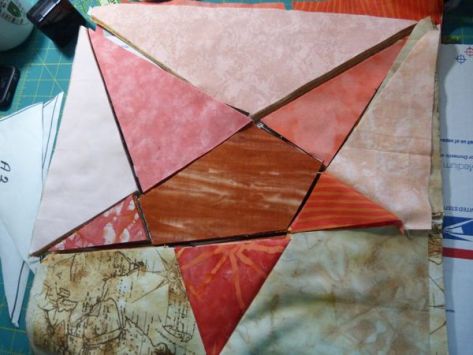
By taking your time and lining things up (it comes easier with practice) you get the interior lines to match up and end up with a fairly straight line. The fairly straight line makes joining the components easier when you sew the major three blocks together.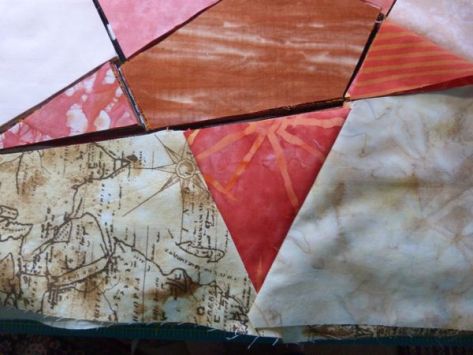
Next, I do the central three blocks, and when I finish them, I line up the star point seams and sew the small sector to the larger central sector. With any luck at all, you’ll have a nice join and the appearance of a straight line. Then you sew the last three pieces (upper left sector) together, focusing on making the interior seam the straight seam.
Because of the way these stars are cut, you are only very rarely ever going to get the last piece to line up at both parts of the center star, so focus on lining up the seam so that you get one straight seam with the join giving you a straight line at the upper right.
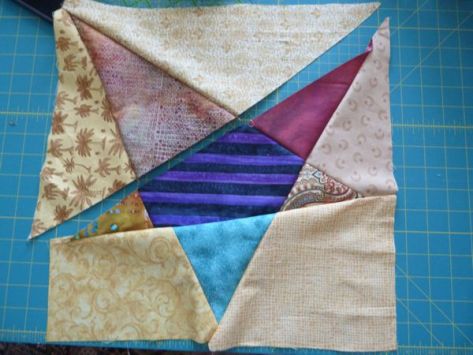
Things don’t always work out. Don’t worry. Wonky blocks are part of the charm of this technique. Two straight lines is great; three straight lines are awesome but all in all – are you having fun? No one is going to nit-pick this quilt, there are too many distractions! (Below is a wonky block I will truly use, but I wanted to show you that no matter how hard I try to be perfect, I am a miserable failure who sometimes doesn’t even manage two straight lines. I am a miserable failure who is having a lot of fun putting these stars together, though 🙂
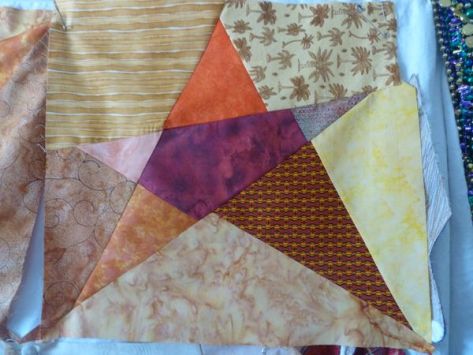
This star comes pretty close to the goal – Four pretty good straight lines, almost five. That fifth just isn’t ever going to happen.
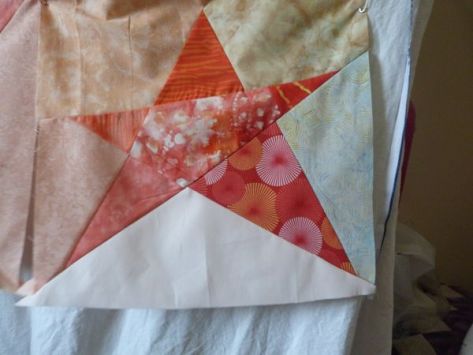
But, even though they are all cut the same way, and I do my best to stitch them the same way, for no apparent reason, now and then one star goes wild. The truth is, no one but you will ever know, but this is why I save my leftover strips after I have trimmed the stars down before slicing.
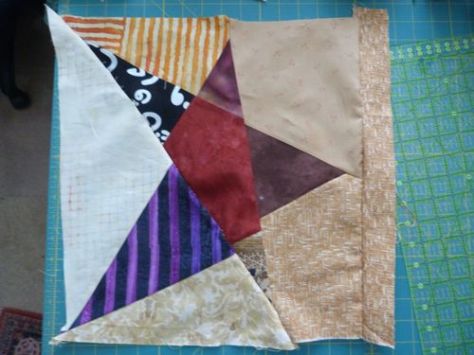
I even took this one apart and restitched it, but no matter what I did, it was dangerously out of whack. I added a one inch strip to the wackiest side, and was able to even everything up within reason, but this will never be a star that gives me satisfaction. It may, however, be one of those blocks that gives a quilt “character.” (When the blocks are sewn together, that addition will disappear . . . you just don’t see it in the wildness of all the diferent patterns and shapes.)
There are a lot of different ways to quilt these stars. In the African series, I used more angular quilting, and I liked it, it looked good with the African fabrics. In some of these quilts, I use a spiral out of the center block, and then elongated squiggles from the central star piece radiating out to the star tips. The background I stipple.














